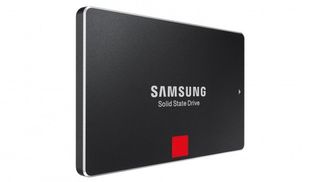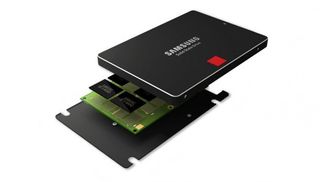Samsung unveil their latest SSD with 3D memory

Over in Seoul Samsung have announced their latest SSD, the 850 Pro. It may just be a standard SATA drive, but it contains an innovative approach to scaling that stacks memory vertically to fit more GBs into the same space.
If SSDs are to completely replace traditional spinning platters for our high-capacity storage needs, they need to start arriving in sizes over a terabyte. For that to happen you either need to strap a vast amount of NAND memory onto your SSD, or make each of those memory chips higher capacity themselves.
The traditional way to increase density has been to shrink down the production process—much like with CPUs and GPUs—but endurance and performance start to drop off the smaller you go. Even when you've done the hard work of hitting a smaller production process the results may not be that pleasing when the new, slower chips start falling over more.

Samsung's solution is to look up. Instead of the traditional horizontally laid-out NAND design they have created 3D NAND chips, called V-NAND in Samspeak, which add transistors vertically as well. Because they can increase density by going vertically as well as horizontally, the new 850 Pro SSDs don't need to run the same 19nm memory as the 840 EVO drives.
The Samsung 850 Pro is using a larger 40nm production process, which means the NAND will have both higher performance and will be more consistent over time too. That's kinda the Holy Grail for current SSDs.
The new drive is still a plain old SATA SSD, so it's not a whole lot faster than the current top crop of solid state drives, but because of the extra memory performance the 850 Pro can saturate the SSD interface at the smallest capacities. In current SSDs the lower capacity drives—the 128GB sort—generally end up quite a way off the pace of the 512GB and 1TB drives. With the 850 Pro that doesn't look like it's going to be the case.
Obviously, with this new tech the Pro drive doesn't come cheap. But this is the first outing for V-NAND and we will see it trickle down into more affordable drives as the technology matures.
The biggest gaming news, reviews and hardware deals
Keep up to date with the most important stories and the best deals, as picked by the PC Gamer team.

Dave has been gaming since the days of Zaxxon and Lady Bug on the Colecovision, and code books for the Commodore Vic 20 (Death Race 2000!). He built his first gaming PC at the tender age of 16, and finally finished bug-fixing the Cyrix-based system around a year later. When he dropped it out of the window. He first started writing for Official PlayStation Magazine and Xbox World many decades ago, then moved onto PC Format full-time, then PC Gamer, TechRadar, and T3 among others. Now he's back, writing about the nightmarish graphics card market, CPUs with more cores than sense, gaming laptops hotter than the sun, and SSDs more capacious than a Cybertruck.
Most Popular


